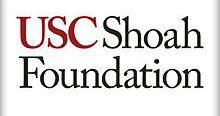Visual History Archive (USC Shoah Foundation and ProQuest)

In 1994, Steven Spielberg, director of the film “Schindler’s List,” established the Survivors of the Shoah Visual History Foundation at the University of Southern California (USC), with a goal to “record on videotape the testimonies of 50,000 survivors and other witnesses of the Holocaust from around the world for educational purposes before it was too late.” This initial undertaking was completed in 1999.
While most of the original 51,696 Holocaust testimonies in the Shoah Foundation’s Visual History Archive came from Jewish Holocaust survivors, testimonies were also obtained from survivors of persecution against the Sinti and Roma (Gypsies), Jehovah’s Witnesses, and homosexuals, from survivors of Nazi eugenics policies, and from political prisoners and forced laborers, as well as from rescuers and aid providers, liberators, and participants in war crimes trials. Subsequently, in keeping with the Shoah Foundation’s mission “to overcome prejudice, intolerance, and bigotry—and the suffering they cause—through the educational use of the Visual History Archive,” the Archive was expanded to include testimonies provided by eyewitnesses to a number of other genocides.
The Visual History Archive provides access to a fully streaming video collection of indexed primary-source testimonies of survivors and witnesses of the Holocaust and other genocides. Within this archive, the largest of its kind, “history is preserved as told by the people who lived it,” and “the vast majority of the testimonies contain a complete personal history of life before, during, and after interviewees’ firsthand experience with genocide.” (A supplementary feature enables the user to connect to contextual and related materials in other ProQuest databases.)
Total number of items: More than 54,400 video testimonies at an average of two hours each.
[Subcollections:] the European Holocaust, 1939-1945 (52,309 interviews); the Armenian Genocide, 1915-1923 (334 interviews); the Tutsi Genocide in Rwanda, 1994 (86 interviews); the Nanjing Massacre, 1937-1938 (30 interviews); the Guatemalan Genocide, 1978-1996 (10 interviews); and the Cambodian Genocide, 1975-1979 (5 interviews)]
- Roughly 116,000 hours of film
- Transcripts being added over time (initially over 900 German transcripts and almost 1,000 English transcripts)
- Almost 65,000 index terms in English
- Over 719,000 images (photographs, documents, works of art, artifacts from war, etc.)
- 9 million names of family members and prominent figures
- Roughly 49,000 location references
- 2,500 recitations of literary works (poems, letters, diaries)
- Over 2,100 musical recitals
- Date range: 1915-1996
- Geographic/language information: The filmed interviews were conducted in 63 countries in more than 40 different languages. Over 27,000 testimonies are in English.
Examples of uses:
The Visual History Archive has served as a major resource for history and genealogy researchers, including individuals drawing on Archive content in producing dissertations and theses, publications, and documentary films. In addition, curricula across a multiplicity of disciplines, in a variety of educational settings from secondary schools to colleges and universities, have made use of Visual History Archive material. Examples of instructional use:
French Literature teaching example
Additional information:
1,600 examples of full-length Visual History Archive testimonies are available on the USC Shoah Foundation’s Visual History Online YouTube platform
Written by: Lydia Wasylenko, Librarian for Citizenship and Humanities, Syracuse University Libraries
